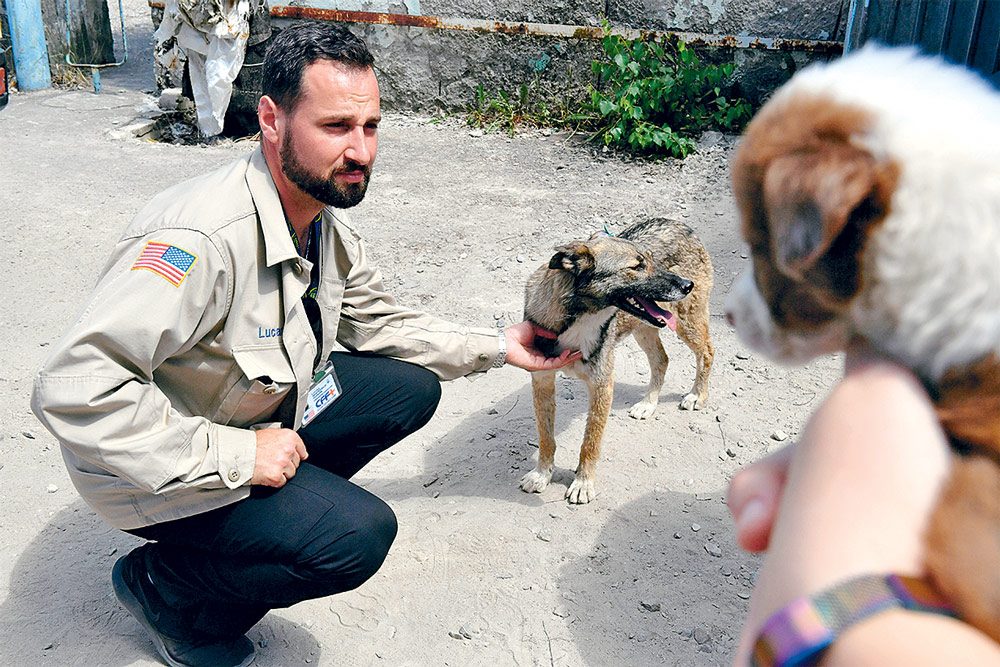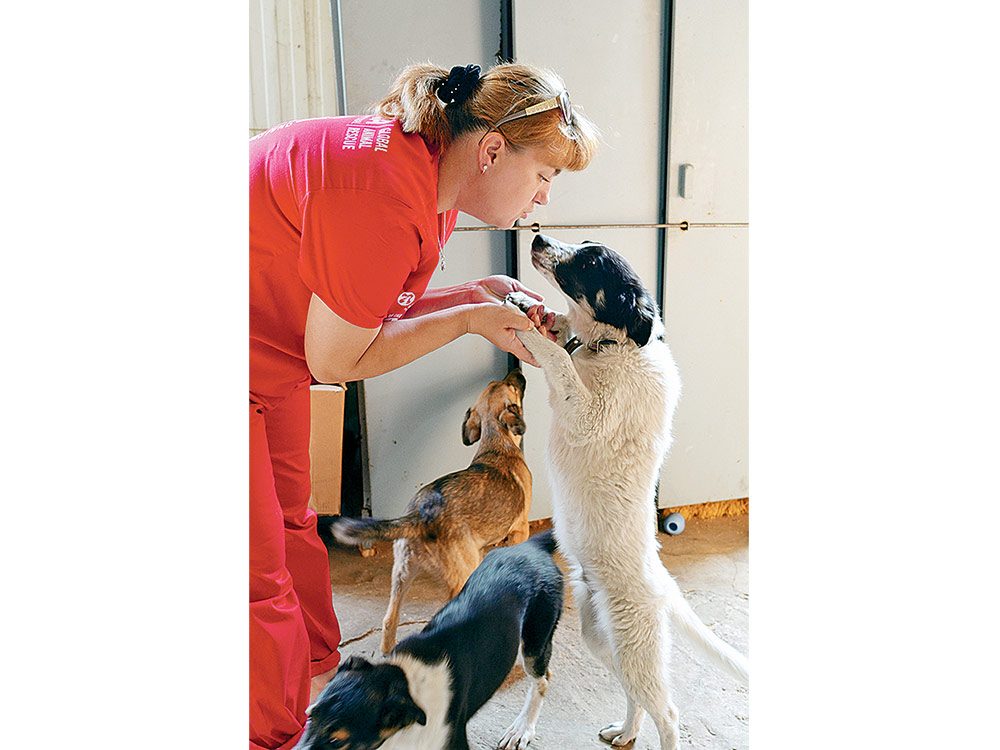
New hope for the Chernobyl puppies
A dozen wriggling puppies with satellite-dish ears and wagging tails scampered behind Natalia Melnichuk, 38, as she carried an oversized bowl of dog food. She stopped walking, turned around and ordered the pups to sit, showing off one of the four commands they were required to know before leaving the small Ukrainian town of Slavutych to find new homes.
It was 2018, and these puppies were about to become the first dogs from an area in Ukraine known as the Chernobyl Exclusion Zone to live abroad with foreigners who adopted them. These Chernobyl puppies had spent their lives in one of the strangest places on earth. It’s a region still grappling with the fallout of Europe’s worst-ever nuclear disaster: a massive accident at the Chernobyl power plant in 1986. Yet they were as normal as any other pups. “If one of them picks up a stick,” Melnichuk said, “everyone else needs the stick.”
The Chernobyl puppies and their older brethren are also Internet famous. One video posted last year racked up nearly six million views on Facebook; another two-minute clip received over a million views in 2017. The earlier video was part of a crowdfunding campaign, organized by the nonprofit Clean Futures Fund, that raised $56,000 to help the dogs. Along with caring for the dogs that live in the Exclusion Zone, an area that’s under special restrictions to limit the impact of the meltdown, CFF provides medical care and other services to the people who continue to be affected by the nuclear accident.
A better future for pups—and people
Lucas Hixson and Erik Kambarian, both from the United States, launched CFF in November 2016. A radiation specialist and a fire chief with expertise in hazardous materials, they first came to the area to work for the Chernobyl power plant. Facing power shortages, authorities kept three reactors running for years after the disaster. The plant is currently in the process of being decommissioned.
The two men were inspired to launch CFF after sitting on a train heading to the Exclusion Zone and seeing an envelope being passed around to collect money for a former plant employee who was unable to pay for cancer treatment from her small pension.
“We felt like we could do more,” Hixson said. “We wanted a better future than the one we’re living in.”
CFF has provided over 130 grants for medicine, health care and surgeries to families living in Slavutych, a town just outside of the Exclusion Zone that was built for evacuees after the explosion. It’s also financed the purchase of a van that kids can take when they need to go to a neighbouring community for treatment. The hospital in Slavutych is so strapped for cash that it’s unable to accommodate special needs, such as developmental disorders.
Still, it’s the Chernobyl puppies that generate the most passion among donors, and the most online attention.
The whirlwind of viral stories about the dog program aren’t always accurate: one outlet called them “feral,” and another claimed that the puppies couldn’t be touched because of radioactivity. Hixson says it’s mostly grown dogs who could have radiation on their skin, and even that’s rare. They haven’t come across a puppy with this issue in the past year and have only seen one or two overall.
“Usually it’s just on their butt, if they sit in something,” Hixson said.

The nuclear disaster that defined a generation
Prior to the spring of 2018, it was illegal to bring dogs out of the Exclusion Zone. But after that changed, it became Melnichuk’s job to care for the pups, with assistance from vets and volunteers, and prepare them for adoption.
They’ve spent plenty of quality time together: Melnichuk enjoys dancing with the puppies to their favourite song, “Despacito,” and named the batch of summer 2018 after famous composers because they liked to sing.
“We know everything about them,” Melnichuk says. “We know every spot on their fur; we know every habit; we know every look. We can even tell now, from a glance, if a dog is not feeling well or if something is bothering it.”
Melnichuk’s sunny disposition is at odds with the horror she lived through some 33 years ago. She was a week shy of her sixth birthday when Reactor 4 at Chernobyl exploded, an accident that killed two people immediately and 28 in the months afterwards. Many more were left sick, and the World Health Organization estimates the final death toll will be in the thousands.
The nuclear accident defined a generation. First responders died slowly, their skin peeling off in chunks. People who lived around the plant developed cancers. Winds spread radiation across the Soviet Union and into Europe—which was how the world learned something was wrong a couple of days later. The Soviet Union had tried to hide the accident.
Like most people who lived in Pripyat, the closest city to the disaster site, Melnichuk’s mother and father worked at the power plant—she as a crane operator and he as a metalworker.
In the panicked aftermath of the explosion, Melnichuk was separated from her sisters and parents and put on a bus headed to Odessa, a city in southern Ukraine. Her hair was shaved off to remove the radiation, and she lived in a seniors’ home for four months while her parents tried to find her. Melnichuk said she’s retained trauma from that period her entire life. From time to time, she still visits her old apartment and her grandfather’s grave in Pripyat, now an abandoned city that attracts intrepid tourists. After her family found her and her sisters, they were sent to Cuba for two years, where her dad worked on building another power plant and she enjoyed the sun and the sea. “I can still remember the taste of the mangoes there,” she says.
The explosion turned Pripyat, surrounding villages and the entire country upside down. Soviet soldiers evacuated residents on buses and wouldn’t let them take much aside from documents and the clothes on their backs. Farms that got citizens through hungry winters were abandoned, along with cows, cats, dogs and other animals. Soldiers later returned to shoot the animals; there were worries they might get radioactive material on their skin and spread it around.
Many of the estimated 900 dogs that live in the Exclusion Zone today are descendants of those that survived culls, winters and attacks by wild animals. Other strays wandered into the zone or were abandoned by owners who no longer wanted to care for them.
Some locals now look out for the dogs. One woman said she cares for as many Chernobyl puppies as she can. Still, by Hixson’s estimation, dogs in the zone don’t live more than six years—not because of the radiation, but because of a lack of food and shelter.
Caring for the Chernobyl puppies
On a sunny day in June 2018, a handful of volunteers with a CFF dog-capture team gathered at a hospital in Chernobyl City. Located within the Exclusion Zone, the town houses tourists and power-plant workers on temporary stays, but nobody is officially allowed to live there because of the still-present radiation.
The team studied a map and identified places where humans might be residing—for where there are humans, there are dogs. Two of the team’s members, Rob Snyder and Michelle Clancy, scouted a street that was thought to have housing but turned out to be a deserted road. As they walked, a dog appeared. Fearful and barking loudly, it responded to a piece of sausage by backing away. The next dogs to show up, however, were so eager for treats that they immediately lay on their backs, tails wagging.
“This, right here, is when I’m happiest,” Clancy said while crouching, surrounded by a group of four or five playful Chernobyl puppies. The dogs were soon collected by the team—some were picked up, while others were lured into cages with treats or sedated with an anesthetic blow dart.
The dogs were then taken to a temporary CFF hospital. Scientists drew blood samples and tested them with a dosimeter (an instrument for measuring exposure to radiation). Veterinarians operated when necessary.
The CFF hospital is filled with improvised equipment and tools. The surgery room of Dr. Jennifer Betz, the vet in charge of the dogs’ health, uses ironing boards for tables and empty pop bottles taped to coat hangers as IV fluid containers. “We just makeshift things,” she said.
Prior to Ukraine, Betz spent five years helping strays in Belize, Mexico, Fiji, Peru and Hawaii. She is based in Portland, Ore., and helps run an organization called Veterinary Ventures, whose mission is to care for animals around the globe. Safety was a concern for Betz before she came to the Chernobyl area, but the dogs are checked for radiation before and after they go through surgery.
After being treated, grown dogs are returned to where they were found while the Chernobyl puppies are sent to horse stables in Slavutych. The small, clean and beautiful town is also where the power-plant workers and volunteers live. Reminders of the nuclear disaster are everywhere—even the local church features icons that depict it as an act of God. It’s in Slavutych that the puppies are placed in Melnichuk’s care.
The puppies’ journey to NYC
Melnichuk met Hixson in 2017, when CFF provided some funds for her son’s 11th surgery. Like many born in the wake of the Chernobyl disaster, he had been diagnosed with a birth defect. His affects his bones. At this time, CFF was already helping plant workers, children and dogs in the region. A year later, it launched its adoption program for Chernobyl puppies and Hixson hired Melnichuk.
In the summer of 2018, CFF set up three temporary animal hospitals as it moved around the Exclusion Zone looking for pups to treat. One was established in Chernobyl City, along Lenin Street, which used to be its main road but is now a strip of abandoned homes with caved-in roofs.
Before the Exclusion Zone authorities allowed CFF to take dogs that have been vaccinated and decontaminated out of the area in 2018, the organization would care for the dogs in makeshift hospitals and release them all, including puppies, back onto the streets. Now, with governmental permission and the help of SPCA International, more than 40 puppies have been adopted to new homes in the United States and Canada.
In July 2018, a few weeks after being taken into CFF’s care, 14 puppies landed at JFK airport in New York. Hixson said the trip involved a three-hour drive from Slavutych to Kiev, then a flight with a layover in Amsterdam.
Some of the puppies stayed at the airport’s pet-transport shelter before getting picked up by their new owners. The rest went to Manhattan on a tour of media outlets.
“People would comment on how beautiful they were and how big their ears were,” Hixson said.
After the trip, Hixson decided to permanently relocate to Ukraine. In a phone call, he talked about his future ambitions, which include helping to clean up the trash left by tourists in Chernobyl and aiding more people who live in the area to access health care. Excitedly, he played a video of two puppies from the same litter reuniting in Ohio. Then he launched into a story about a 13-year-old boy who took his first steps after multiple surgeries and receiving mobility equipment financed by CFF.
“It was just incredible,” he said.
He hopes that the puppies’ journey will help accomplishments like this one—and the ongoing needs of Chernobyl’s people—get the attention they deserve.
To learn more about this historic disaster, read about the HBO drama Chernobyl in our round-up of top TV picks.